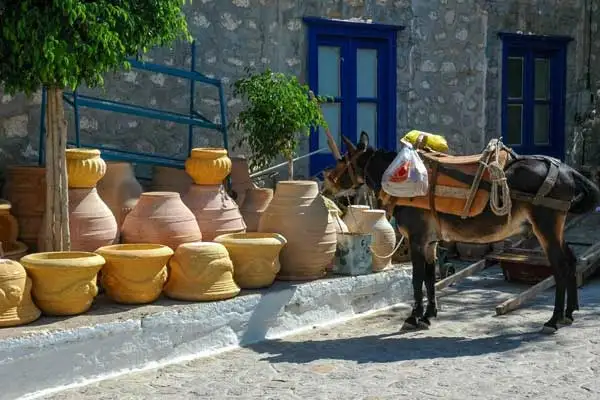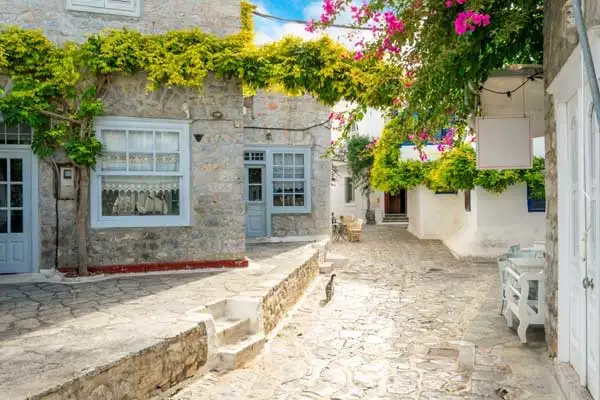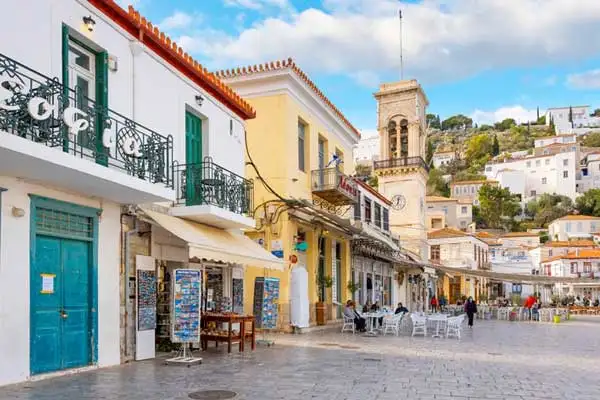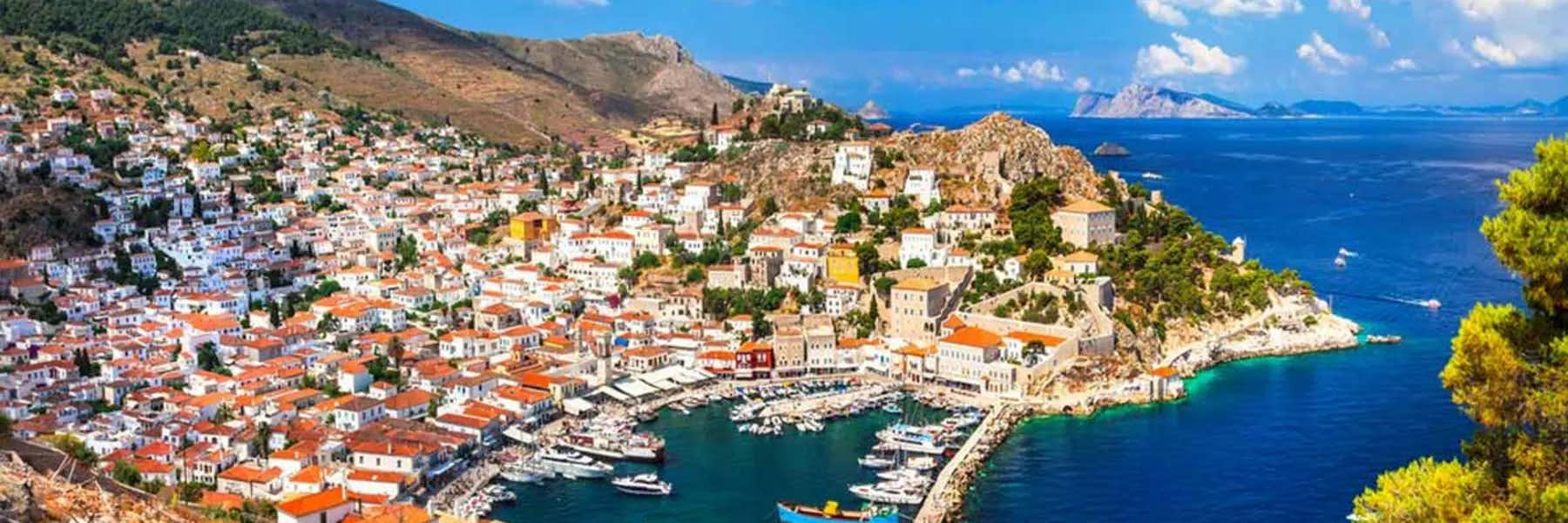Surrounded by the azure Aegean Sea, the island of Hydra comes with all the trimmings you’d expect from a little Greek oasis... gorgeous coastal views, a hot climate, and Old World charm. And it’s one of the few Greek islands that’s “wheel-free”—no cars, motorbikes, or even bicycles. Everyone on Hydra gets around on foot, by donkeys, and in sea taxis.
About 100 nautical miles southwest of Athens, this small island of just 19 square miles is popular with day trippers from the big city and has a sophisticated, jet-set appeal. But it wasn’t always so up-market.
In the early 1960s, Hydra became a hub of creativity, ushering in a golden age of artistic expression. It became well known for attracting famous artists, writers, and poets—legends in their respective crafts, such as the Greek painter Panayiotis Tetsis, Allen Ginsberg, Pablo Picasso, and even John Lennon.
It also lured Canadian writer, poet, and singer/songwriter Leonard Cohen. As a young man in his mid-20s, Cohen washed up on Hydra’s sunny shores to connect with the literati who’d established the island as their base.
In these early days, Cohen was more of an aspiring novelist and poet. His bohemian lifestyle of writing in the mornings until the early afternoon, followed by a swim in the Aegean, and a siesta before the evening meal and a night of heavy drinking, apparently got the artistic juices flowing.
Six months after settling in to life on Hydra, Cohen received word that his grandmother in Montreal had died, leaving him $1,500. He knew immediately what he would spend this inheritance on...
In September 1960, 26-year-old Cohen bought a 200-year-old villa in Hydra. Three stories high with plain white walls, the villa lay in a cluster of buildings between Hydra Town and Kamini, the next little village up the hill. This was to serve as his home for the next seven years.
This era of relative privacy elicited a creative deluge: A book of poems (Flowers for Hitler, 1964), and two novels (The Favourite Game—which won him the “Prix Litteraire du Quebec” award in 1964—and Beautiful Losers, 1966).
As Cohen’s career flourished and his fame grew, he would periodically return to Hydra, and the villa was inherited by his children... who are regular visitors to this day.
I read Cohen’s biography following his death in 2016 at the age of 82, which reignited my interest in Hydra, Cohen, and the unique lifestyle the island offers...
Hydra is the ideal escape from bustling city life and everyday routine. I recently made the pilgrimage up to the Athens port city of Piraeus from my home in the Cyclades, and then caught the fast ferry to Hydra, a 90-minute ride. (In summer there are around seven daily departures from Piraeus. See more about the timetable and how to book your tickets here).

The port itself is quite small; it’s only able to accommodate smaller yachts and the fast ferries. The largest vessels are the transport boats that bring the island its essential supplies from the mainland. Once dockside, the goods are then transported by the ubiquitous donkeys throughout the island.
There were no signs of the massive cruise liners that line the shores of Mykonos or Santorini, dispensing thousands of tourists daily. Though I arrived in peak summer season, and the port was teeming with activity, there is still an intimacy to this place that adds to its unique charm.
Another thing that sets Hydra apart from its more famous neighbors is the architecture. There is much more of an Italian influence here—you’ll see many stone buildings with terracotta-tiled roofs. There’s also more rainfall in this part of Greece, so the landscape is greener than on other islands, with conifers and pine trees aplenty.
I spent my first hours wandering around the beautiful cobbled streets of the old town, admiring the flower-adorned houses and the well-preserved stone mansions built into the towering rocks that are the foundation of this town.
There are also many monuments to commemorate the island’s long and illustrious history. Admiral Andreas Miaoulis, Greece’s foremost naval hero in the War of Independence with the Turks in the 1820s, was born here and his Red House is a shrine for Greek tourists.

To find a place to stay, I did it the old-fashioned way and asked around—the local shopkeepers pointed me in the direction of a pension about 100 feet from the waterfront, and there I got a room with a private bathroom for €55 a night. It was time to retrace the steps of Leonard Cohen.
I’d read that he used to hang out with the Australian writers George Johnston and Charmian Clift (amongst others) at the Katsikas grocery store on the waterfront. Conveniently, the store had a back room that doubled as a small café and bar. Tables outside overlooked the water, presenting the ideal location for expats to congregate and wait for the daily ferry arriving around noon from Piraeus. (The ferry brings the mail, which often contains eagerly awaited income checks, and of course a fresh group of people.)

After talking with some of the locals, I discovered that the original Katsikas grocery is now the more up-market Roloi Café, directly in front of the town’s main clock tower (roloi means clock in Greek). It was here, around the back of the original Katsikas grocery, where Leonard had performed—with just his guitar—for a few close friends.
The tables overlooking the water are still there, and I had my first cappuccino in Hydra in the exact same spot where Cohen performed over 60 years ago.
The following day (again, with the help of a few locals) I managed to locate Cohen’s villa. It was a 10-minute walk from the waterfront up a steep, winding laneway.
Initially, I found myself lost in the labyrinth of winding alleyways, but was eventually pointed in the right direction by the gruff corner store proprietor, who, on hearing “the name” gave a casual nod in the general direction I should be going.
On a quiet corner, I finally spotted a wall sign that read “Odos Leonard Cohen – Dimos Hydra,” confirming my discovery. Today, the villa is well maintained, with white stucco walls and tasteful dark grey colored timber doors, windows, and shutters.
Back in the 60s when Cohen bought this house, it had no electricity or plumbing. A water cistern collected winter rains, and when that ran out in summer, he relied on an old man who passed on his donkey every few days, weighed down on both sides with water containers.
Cohen’s former residence is still a private home—you can’t visit inside. But it’s a modest, compact villa fully occupying a small plot of land. (There’s likely a glimpse of the sea from the upstairs rooms.) It’s from this simple abode that famous songs were composed—like Cohen’s Bird on a Wire.
With my mission accomplished, I was now able to explore some of the island’s other attractions. Because Hydra is a relatively small island, and thanks to the lack of vehicles, hiking is popular here.
The 40-minute hike from town to the small village of Mandraki, Hydra’s old military harbor, is ideal for less experienced hikers. Along the way, you’ll pass the ruins of the small seaside castle of Kastraki that dates to the 17th century. Mandraki Beach, in a sheltered cove, is the only sand beach on the island, and the water here is shallow and warm.
For the more experienced hikers, the steep two-hour trek to the Monastery of Prophet Elias is well worth the effort (the track gets more challenging the higher you go). At 1,640 feet above sea level, the views from the top are spectacular. The monastery was established in 1813 by monks from Mount Athos. It’s still a working monastery and is known for its library filled with valuable manuscripts.
Diving is also popular on the island. The waters around the island are home to reefs teeming with marine life and underwater caves. Diving trips can be organised through the tourist office in town.
For history buffs, a visit to the Museum of Historical Archives Museumis a must. Housed in a restored stone mansion originally built by a Hydra shipbuilder, located on the town’s waterfront. It offers special insight into role the island played in the 1821 Greek Revolution.
Hydra today is a not quite Cohen’s Hydra. It’s become a high-end retreat for Athenians and a popular day trip from the capital. And that means higher prices—especially during the summer months. A cappuccino at a waterfront café will set you back about $5 in some places, and dinner (two courses with wine) will come in at about $35 to $45 per person in restaurants around the waterfront and in the tavernas in the nearby back streets.
The tranquility and sense of freedom that inspired Cohen and other artists in the 60s may have been replaced by a more cosmopolitan vibe, but Hydra’s charm and beauty are still well worth the trip... whether you’re a Cohen fan or not.
